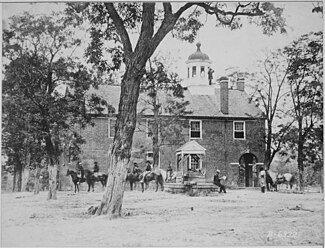Battle of Fairfax Court House (June 1861)
| Battle of Fairfax Court House | |||||||
|---|---|---|---|---|---|---|---|
| Part of the American Civil War | |||||||
 Fairfax Court House, Virginia by Matthew Brady From U.S. National Archives |
|||||||
|
|||||||
| Belligerents | |||||||
|
|
|
||||||
| Commanders and leaders | |||||||
|
Irvin McDowell David Hunter Charles Henry Tompkins |
Milledge Luke Bonham Richard S. Ewell (WIA) John Quincy Marr † William "Extra Billy" Smith |
||||||
| Strength | |||||||
| Between 50 and 86 | Between 40 and 80 engaged | ||||||
| Casualties and losses | |||||||
| 1 killed 4 wounded 3 captured |
1 killed 2 wounded 5 captured |
||||||
The Battle of Fairfax Court House was one of the first land engagements of the American Civil War, when a Union scouting party clashed with the local militia in the village of Fairfax Court House, Virginia on June 1, 1861. It saw the first death in action of a Confederate officer, and the first wounding of a Confederate officer of field grade.
The Union had sent a regular cavalry unit under Lieutenant Tompkins to estimate enemy numbers in the locality. At Fairfax Court House, they surprised a small Confederate rifle company under Captain Marr, and took some prisoners. Marr rallied his unit, but was killed, and command was taken over by a civilian ex-governor of Virginia, William Smith, who forced the Union to retreat.
The engagement is judged to have been inconclusive. The Union did not gain the intelligence it was seeking, and had to delay its drive on Richmond, thus enabling the Confederates to build-up their strength at Manassas in advance of the much-bigger battle there, the following month. Tompkins was criticised for exceeding his orders, although they had been somewhat imprecise.
On April 15, 1861, the day after the U.S. Army surrendered Fort Sumter in the harbor Charleston, South Carolina to Confederate forces, President Abraham Lincoln called for 75,000 volunteers to reclaim federal property and to suppress the rebellion begun by the seven Deep South states which had formed the Confederate States of America (Confederacy). Four Upper South States, including Virginia, refused to furnish troops for this purpose and began the process of secession from the Union with the intent of joining the Confederacy. On April 17, 1861, the Virginia Secession Convention began in Richmond, Virginia for the purpose of considering the secession of Virginia. A majority of the delegates immediately passed an ordinance of secession and authorized the governor to call for volunteers to join the military forces of Virginia to defend the state against Federal military action. Virginia Governor John Letcher appointed Robert E. Lee as commander in chief of Virginia’s army and navy forces on April 22, 1861 at the grade of major general. On April 24, Virginia and the Confederate States agreed that the Virginia forces would be under the overall direction of the Confederate President pending completion of the process of Virginia joining the Confederate States. These actions effectively took Virginia out of the Union despite the scheduling of a popular vote on the question of secession for May 23, 1861.
...
Wikipedia
